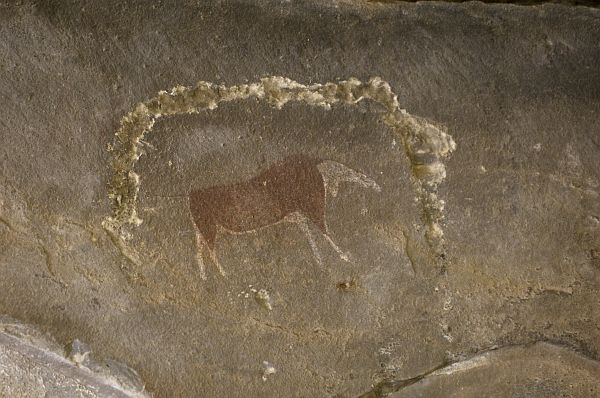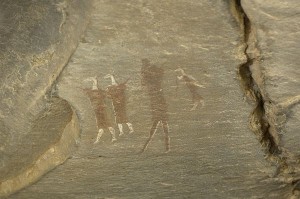I have been fascinated by cave paintings (also known as rock art) since I was a little child. I am just amazed that someone could tell a story hundreds, perhaps even thousands of years ago and here we are in the 21st century able to still read it and imagine the people and their lives from such a long, long time ago. South Africa has some of the best cave paintings or rock art sites in the world and many of them are close to the lodges and safari camps that we use on our itineraries.
Drakensberg and Kamberg
South Africa is an incredibly rich source of cave paintings and one of the best areas to see many of them in in Kwazulu Natal in the stunningly beautiful Drakensberg Mountains. The San people (also known as Bushman) created beautiful rock paintings and engravings which you can see all around this area. There are over 40,000 of them in this area alone so they were pretty prolific! There are various walking tours that take you to sites that are close together and these trails usually have an information centre where you can learn more about them or hire a guide to show you around.
The Kamberg San Rock Art Trail is amazing and includes such sites as the Game Pass Shelter. The San paintings are now national monuments protected by law but were first discovered back in the early 1900s. At first they were thought to be simple depictions of daily life such as hunting but nowadays experts believe that the artwork is actually made up of mystical images that were seen by shamans whilst in a trance. They reflect the spirituality of the San who believe that men can take on the powers of animals through a shaman in a trance and the animals depicted are more about the wellbeing of the tribe rather than actual hunting. The most common subject matter for rock art by the San includes animals, especially the eland antelope, human figures and therianthropes which depict the metamorphosis from human to animal.
Among the most accessible of the many Drakensberg rock art sites is the open-air Bushman Cave Museum in the Giant’s Castle Reserve, established in 1903 and run by KwaZulu-Natal Nature Conservation. A short walk takes you to the cave, which features 500 rock paintings, some of which are estimated to be around 800 years old. However if you are a fit and adventurous hiker you can take yourself off to more remote trails where you will be able to discover caves on your own!
Northern Cape
There are over 400 rock etchings at the Wildebeest Kuil Rock Art Centre outside Kimberley in the Northern Cape. Dating back as far as about 1,800 years these are some of the oldest examples of rock art in South Africa. From the older hairline engravings to the more recent pecked-out shapes and relatively modern middens, Later Stone Age groups (ancestors of the San), the KhoeKhoe and various waves of colonists have all left their marks in this area.
Another great area for Rock Art in South Africa is the Clanwilliam Living Landscapes Project on the Western Cape where you can follow the Sevilla Trail and the Warmhoek Trails to see some more incredible examples. The CLLP is a community-based heritage and education project aimed at highlighting the living legacy of the San people that once lived in the Cederberg many thousands of years ago. The visitor can use the landscape as a time machine and ‘travel’ through using the wealth of archaeological material continually discovered here including rock art, structural remains and human artefacts, to connect to the lifestyle, beliefs and wisdom of the ancient San people. The Cedarberg area is so rich in pre-historic sites that it is now protected as a UNESCO World Heritage Site. In fact the rock art on the Sevilla Rock Art Trail is thought to be between 8,000 and 800 years old. Although there is still some dispute over the age of rock art, the latest dating methods show that the oldest specimens of this San rock art are more than three times older than the Egyptian pyramids!
In fact there are so many sites in South Africa yo u could spend your whole holiday looking at rock art and still not see it all! We have some fantastic accommodation close to these areas and especially in Kwazulu Natal and the Drakensberg Mountains so if you fancy taking a look for yourself just let us know! I will be looking at other rock art sites across Africa so check out the blog to see more in the future.
Posted by Ruth Bolton

